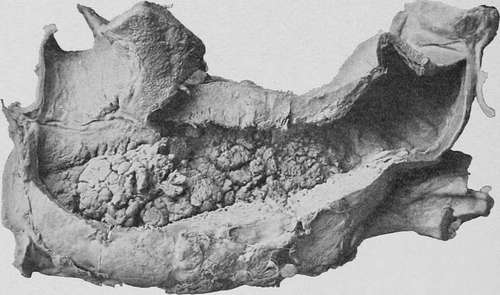Carcinoma Of The Body (Walls And Curvatures)
Description
This section is from the book "Cancer And Other Tumours Of The Stomach", by Samuel Fenwick. Also available from Amazon: Cancer and other tumours of the stomach.
Carcinoma Of The Body (Walls And Curvatures)
Growths which affect the central region of the stomach are usually extensive, of soft consistence, and of rapid growth, and are consequently accompanied by numerous symptoms and important physical signs. Pain is experienced in the majority of the cases, and is usually increased by food, while sloughing of the growth or implication of the peritoneum often gives rise to acute and continuous suffering. Vomiting is an inconstant phenomenon, and chiefly occurs during the periods of digestion or in the early morning. Nausea and retching are common sources of complaint, and anorexia, loss of flesh, and cachexia are invariably present. Haematemesis is frequent but variable in quantity, a coffee-ground appearance of the vomit indicating oozing from the surface of the neoplasm, while the ejection of bright blood is usually associated with ulceration of the growth. Fatal haemorrhage may ensue from the destruction of a large artery, and general or local peritonitis from perforation of the coats of the stomach. When metastases develop in the liver or peritoneum at an early period, the symptoms due to the primary disease often diminish or even subside. In many cases there is an elevation of temperature. Death usually takes place from exhaustion within twelve months, and in only about 13 per cent, is life prolonged, for more than a year.

Fig. 50.- Stomach viewed from behind, showing enormous infiltration of its walls with soft spheroidal-celled carcinoma, and its cavity almost obliterated by a cauliflower growth. (London Hospital Museum.).
A palpable tumour exists in about 81 per cent, of the cases, and usually occupies the epigastric, umbilical, or left hypochondriac region. It presents a nodular surface, an indefinite outline, a dull note on light percussion, and is movable by palpation and with respiration. Examination shows that the stomach is moderately dilated, and that its contents are free from hydrochloric acid. Small particles of the neoplasm or cells showing atypical mitoses may be extracted by a tube, and the Oppler-Boas bacillus often accompanies the signs of lactic acid fermentation. Thrombosis of the veins of the lower extremities and metastases in the abdominal wall are not infrequent.
Continue to:
